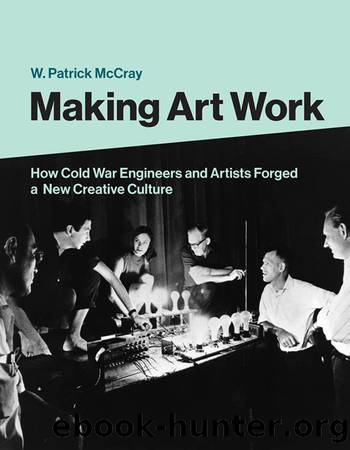Making Art Work by W. Patrick McCray

Author:W. Patrick McCray [McCray, W. Patrick]
Language: eng
Format: epub
Publisher: MIT Press
Published: 2020-09-25T00:00:00+00:00
A Divinity of Wonders
The art-and-technology movement drew people to it for many reasons. Its focus on experimentation and collaboration attracted some devotees. The possibilities inherent in working with new materials and processes pulled in others. And, for many, merging art and technology offered opportunities for personal growth and professional development. For physicist Elsa M. Garmire, all of these factors enticed her to join the burgeoning art-and-technology community emerging in Southern California.
Born in 1939, Garmire grew up around Buffalo, New York. Her father was a chemical engineer and her mother taught music. The launch of Sputnik in October 1957, during her freshman year at Radcliffe College, brought renewed public attention and lots of federal funding to science and engineering. But Garmire had decided years earlier to pursue a science career, a decision which made her stand out among classmates who tended to gravitate toward the humanities. Garmire remained in Cambridge for graduate work in physics at MIT. Her advisor, Charles H. Townes, was a key figure in the invention of the laser, research which earned him a share of the Nobel Prize in Physics in 1964. Garmireâs own research on ruby lasersâchosen partly because of the âfascinatingly beautifulâ red light they made and also because the topic itself was so newârequired her to design and build clever lab experiments. In August 1965, two weeks after her first child was born, Garmire defended her dissertation. The next year, she and her husband (also a physicist) moved to Caltech where she took up a postdoctoral appointment in electrical engineering.53
Her new academic environment was markedly different from what she had experienced at MIT. When Garmire arrived in Pasadena, the school had only a few women graduate students and no women undergraduates. Just as Caltechâs leaders fretted over how to boost the schoolâs offerings in the humanities, admitting women was framed primarily in terms of placating the schoolâs male students. Women, they reasoned, offered potential social partners for male students while their âliberal-arts-mindâ could expand the intellectual horizons for Caltechâs âeunuchs of science.â54 Her husbandâhe was on Caltechâs tenure track, though she wasnâtâworked long hours and Garmire had few friends and no other women scientists at Caltech to provide mentorship. With a marginal and temporary position in an engineering department, Garmire found Caltech unsatisfying. She set up her own laser laboratory but judged her results ânot terribly impressiveâ compared to what she had been used to at MIT. Feeling âstifled and unsuccessfulâ Garmire started to look for more satisfying outlets for her skills.55
Garmire learned about E.A.T. in 1968 from Barbara T. Smith, an artist from Southern California who was acquainted with members of the Judson Dance Theatre. Smith had recently started making avant-garde art using a Xerox copy machine she had installed in her Pasadena dining room. One of the first American artists to experiment with this new technology, Smith combined images of family photographs, food, household objects, and her own body into a series of handmade books she titled Coffins. Smith was also in
Download
This site does not store any files on its server. We only index and link to content provided by other sites. Please contact the content providers to delete copyright contents if any and email us, we'll remove relevant links or contents immediately.
Wonder by R.J. Palacio(8430)
Mastering Adobe Animate 2023 - Third Edition by Joseph Labrecque(3720)
Unlabel: Selling You Without Selling Out by Marc Ecko(3574)
Ogilvy on Advertising by David Ogilvy(3485)
Hidden Persuasion: 33 psychological influence techniques in advertising by Marc Andrews & Matthijs van Leeuwen & Rick van Baaren(3454)
Drawing Cutting Edge Anatomy by Christopher Hart(3440)
The Pixar Touch by David A. Price(3347)
POP by Steven Heller(3297)
The Code Book by Simon Singh(3057)
The Art of War Visualized by Jessica Hagy(2932)
Slugfest by Reed Tucker(2924)
The Curated Closet by Anuschka Rees(2897)
Rapid Viz: A New Method for the Rapid Visualization of Ideas by Kurt Hanks & Larry Belliston(2815)
Stacked Decks by The Rotenberg Collection(2796)
365 Days of Wonder by R.J. Palacio(2737)
The Wardrobe Wakeup by Lois Joy Johnson(2717)
Keep Going by Austin Kleon(2682)
Tattoo Art by Doralba Picerno(2583)
Tell Me More by Kelly Corrigan(2579)
